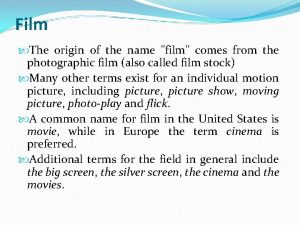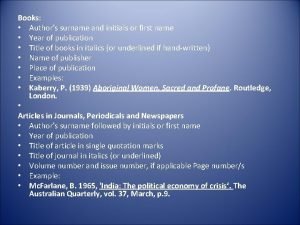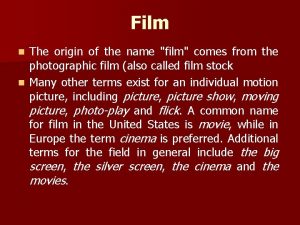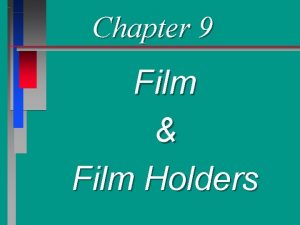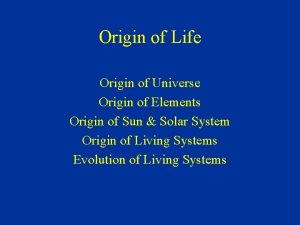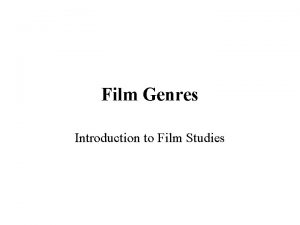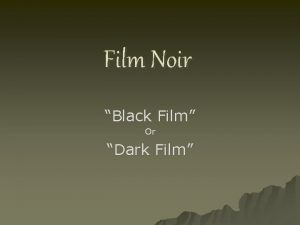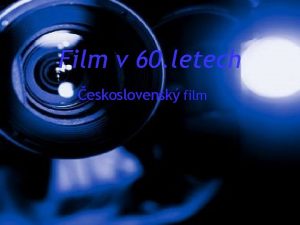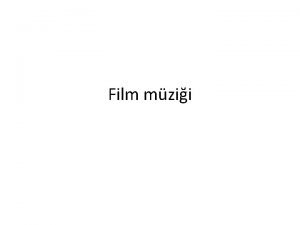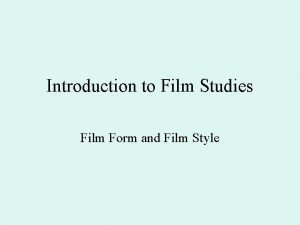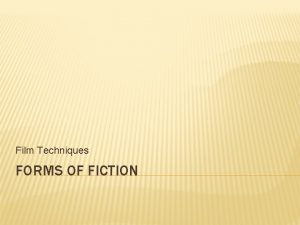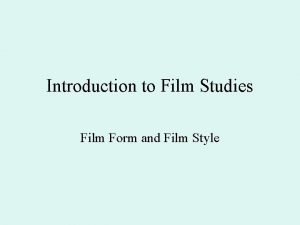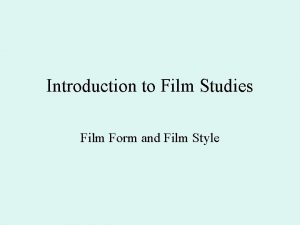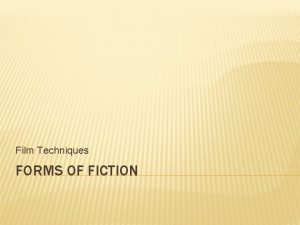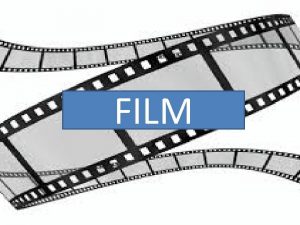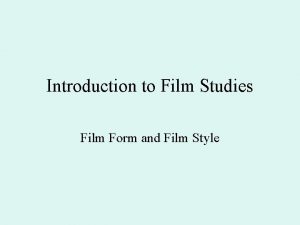Film The origin of the name film comes





















































- Slides: 53

Film The origin of the name "film" comes from the photographic film (also called film stock) Many other terms exist for an individual motion picture, including picture, picture show, moving picture, photo-play and flick. A common name for film in the United States is movie, while in Europe the term cinema is preferred. Additional terms for the field in general include the big screen, the silver screen, the cinema and the movies.

History of Film Camera Obscura invented in the 6 th century. Described by Alhazen in his Book of Optics (1021). Al-Haitham (Alhazen) conducted experiments on the propagation of light and colors, optic illusions and reflections. A camera obscura is an optical device that led to photography and the camera. The device consists of a box or room with a hole in one side.

camera obscura

History of Film 17 th Century Use of Magic Lanterns

1895 Lahore - general view of railway station by William Henry Jackson

History of Film 1827 First still photograph taken, Claude Niepce's photograph The View from a Window at Le Gras took nearly eight hours to expose.


Latticed window at Lacock Abbey 1835

History of Film 1832 Joseph Plateau and sons introduce the Phenakistoscope. The phenakistoscope was an early animation device that used a spinning disk of sequential images and the persistence of vision principle to create an illusion of motion. Cyclist (small, medium, large)


History of Film 1834 Another illusion toy The Zoetrope introduced by William George Horner. A zoetrope is one of several prefilm animation devices that produce the illusion of motion by displaying a sequence of drawings or photographs showing progressive phases of that motion. Zoetrope's were widely sold after 1867.

Zoetrope

History of Film The praxinoscope was an animation device, the successor to the zoetrope. It was invented in France in 1877 by Charles-Émile Reynaud. Like the zoetrope, it used a strip of pictures placed around the inner surface of a spinning cylinder. Praxinoscope was viewed on mirrors in the centre of the drum rather than through slots on the outside.



Eadweard Muybridge Eadweard James Muybridge was an English photographer important for his pioneering work in photographic studies of motion, and early work in motionpicture projection

Eadweard Muybridge was asked, in 1873, by the ex-governor of California - Leland Stanford to settle a bet as to whether horses hooves left the ground when they galloped.


Eadweard Muybridge is known for his pioneering work on animal locomotion in 1877 and 1878, which used multiple cameras to capture motion in stopmotion photographs, and his zoopraxiscope, a device for projecting motion pictures that pre-dated the flexible perforated film strip used in cinematography

History of Film 1888 George Eastman devises a still camera which produces photographs on sensitized paper. An American innovator and entrepreneur who founded the Eastman Kodak Company and popularized the use of roll film, helping to bring photography to the mainstream

Thomas Edison and Dickson

History of Film Thomas A. Edison, with his assistant W. K. L Dickson (who did most of the work), then acquired some Eastman Kodak film stock and began work on a new type of machine. By 1891, Edison and Dickson have their Kinetograph camera and Kinetoscope viewing box.

Kinetoscope and Black Maria

Butterfly Dance

First Camera 1892 Using his projecting Praxinoscope, Reynaud holds the first public exhibitions of motion pictures. Reynaud's device was successful, using long strips of hand-painted frames, but the effect was jerky and slow. http: //en. wikipedia. org/wiki/Charles%C 3%89 mile_Reynaud

Auguste Lumiere Louis Lumiere

Cinématographe 1894 The Lumière family is the biggest manufacturer of photographic plates in Europe. Louis and Auguste design a camera which serves as both a recording device and a projecting device. They call it the Cinématographe.

Cinématographe

First Film 1895, La Sortie de l'usine Lumière a Lyon (Workers leaving the Lumière factory at Lyon).

Lumière films 1895 One of the most famous film screenings in history took place on December 28 th, 1895. The venue was the Grand Cafe in Paris and customers paid one Franc for a twenty-five minute programme of ten Lumière films. These included Feeding the Baby, The Waterer Watered and A View of the Sea.

1902: Georges Méliès produces his magnificent "Voyage to the Moon",

Voyage to the Moon A fifteen minute epic fantasy parodying the writings of Jules Verne and HG Wells. The film used innovative special effect techniques and introduced colour to the screen through handpainting and tinting.

Mary Jane's Mishap 1903 British film maker George Smith makes Mary Janes Mishap Praised for its sophisticated use of editing. The film uses medium close-ups to draw the viewers attention to the scene Juxtaposed with wide establishing shots. The film also contains a pair of wipes which signal a scene change.

1903 Edwin S. Porter, working for Edison makes "The Life of an American Fireman“ Displayed new visual storytelling techniques

Edwin S. Porter Incorporated stock footage with Porter's own photography. "The Life of an American Fireman“ acted as a major precursor to Porter's most famous film "The Great Train Robbery“ It was made in 1903 Displayed effective use of editing and photography technique.

Silent Films began developing a narrative structure Stringing scenes together to tell narratives. The scenes were later broken up into multiple shots of varying sizes and angles. Other techniques such as camera movement were realized as effective ways to portray a story on film. Rather than leave the audience in silence, theater owners would hire a pianist or organist or a full orchestra to play music fitting the mood of the film at any given moment.

Silent Films By the early 1920 s, most films came with a prepared list of sheet music. Complete film scores being composed for major productions.

Silent Films Acting techniques Silent film actors emphasized body language and facial expression so that the audience could better understand what an actor was feeling and portraying on screen. Silent comedies tend to be more popular in the modern era than drama, partly because overacting is more natural in comedy. The melodramatic acting style was in some cases a habit actors transferred from their former stage experience.

Silent films in Hollywood The rise of European cinema was interrupted by the outbreak of World War I. The film industry in United States flourished with the rise of Hollywood, typified most prominently by the great innovative work of D. W. Griffith in The Birth of a Nation (1914) and Intolerance (1916). However in the 1920 s, European filmmakers such as Sergei Eisenstein, F. W. Murnau, and Fritz Lang, in many ways inspired by the meteoric war-time progress of film through Griffith, along with the contributions of Charles Chaplin, Buster Keaton and others, quickly caught up with American filmmaking and continued to further advance the medium.

D. W. Griffith David Wark Griffith (January 22, 1875 – July 23, 1948) was a premier pioneering American film director. He is best known as the director of the controversial and groundbreaking 1915 film The Birth of a Nation and the subsequent film Intolerance (1916). Griffith's film The Birth of a Nation made pioneering use of advanced camera and narrative techniques, and its immense popularity set the stage for the dominance of the feature-length film.

First Film with Sound The first feature-length film with synchronized sound effects and musical soundtrack (canned music and sound effects), but without dialogue, was Warner Bros. ' romantic adventure Don Juan (1926). It was premiered in New York in August 1926, and starred John Barrymore

The Jazz Singer (1927 film) The Jazz Singer (1927) is an American musical film. The first feature-length motion picture with synchronized dialogue sequences, its release heralded the commercial ascendance of the "talkies" and the decline of the silent film era. Produced by Warner Bros. with its Vitaphone sound-on-disc system, the movie stars Al Jolson, who performs six songs. Directed by Alan Crosland, it is based on a play by Samson Raphaelson.

Cinema of India

Cinema of India is the world's largest producer of films. In 2009, India produced a total of 2961 films on celluloid, that include a staggering figure of 1288 feature films. The provision of 100% foreign direct investment has made the Indian film market attractive foreign enterprises such as 20 th Century Fox, Sony Pictures, and Warner Bros. Prominent Indian enterprises such as Zee, UTV, Adlabs and Sun Network's Sun Pictures also participated in producing and distributing films.

Cinema of India Following the screening of the Lumière moving pictures in London (1895) cinema became a sensation across Europe and by July 1896 the Lumière films had been in show in Bombay (now Mumbai). The first short films in India were directed by Hiralal Sen, starting with The Flower of Persia (1898).

The first full-length motion picture in India was produced by Dadasaheb Phalke, a scholar on India's languages and culture. He brought together elements from Sanskrit epics to produce his Raja Harishchandra (1913), a silent film in Marathi.

Cinema of India Interestingly, the female roles in the film were played by male actors. http: //www. youtube. com/watch? v=De. Tnb. Enjh 64 During the early twentieth century cinema as a medium gained popularity across India's population and its many economic sections.

Cinema of India Tickets were made affordable to the common man at a low price and for the financially capable, additional comforts meant additional admission ticket price. Audiences thronged to cinema halls as this affordable medium of entertainment was available for as low as an anna (4 paisa) in Bombay. The content of Indian commercial cinema was increasingly tailored to appeal to these masses.

Ardeshir Irani released Alam Ara, the first Indian talking film, on 14 March 1931.

Cinema of India Following the inception of 'talkies' in India some film stars were highly sought after and earned comfortable incomes through acting. As sound technology advanced the 1930 s saw the rise of music in Indian cinema with musicals such as Indra Sabha and Devi Devyani marking the beginning of song-and-dance in India's films.

Cinema of India Following India's independence, the period from the late 1940 s to the 1960 s are regarded by film historians as the 'Golden Age' of Indian cinema. Some of the most critically acclaimed Indian films of all time were produced during this period. In commercial Hindi cinema, examples of famous films at the time include the Guru Dutt films Pyaasa (1957) and Kaagaz Ke Phool (1959) and the Raj Kapoor films Awaara(1951) and Shree 420 (1955). These films expressed social themes mainly dealing with working-class urban life in India;

Cinema of India The period also saw the emergence of a new Parallel Cinema movement, mainly led by Bengali cinema. Early examples of films in this movement include Chetan Anand's Neecha Nagar (1946), Ritwik Ghatak's Nagarik (1952), and Bimal Roy's Two Acres of Land (1953), laying the foundations for Indian neorealism and the "Indian New Wave". Pather Panchali (1955), the first part of The Apu Trilogy (1955– 1959) by Satyajit Ray, marked his entry in Indian cinema. The Apu Trilogy won major prizes at all the major international film festivals and led to the 'Parallel Cinema' movement being firmly established in Indian cinema.

Pakistani Cinema Immediately following the partition, the newly founded Pakistan faced a brain drain where all its highly talented and skilled workers migrated to India, including most actors and directors. Shortage of filming equipment further paralyzed the nation's film industry. With much hardships faced, the new film industry was able to produce its first feature film, Teri Yaad on 7 August, [ 1948, premièring at the Parbhat Theatre in Lahore. The following year, Evernew Studios established a studio in the country which would later become the largest film company of the time. Over the next few years, films that were released reached mediocre success until the release of Do Ansoo on 7 April 1950. Do Ansoo became the first film to attain a 25 -week viewing making it the first film to reach silver jubilee status.
 First comes love then comes marriage
First comes love then comes marriage Name
Name The origin of film
The origin of film Hosanna blessed is he who comes in the name of the lord
Hosanna blessed is he who comes in the name of the lord Explain wedge film and squeeze film journal bearings
Explain wedge film and squeeze film journal bearings The origin of species chapter 18 manga
The origin of species chapter 18 manga Borges last name origin
Borges last name origin Eminem name origin
Eminem name origin Hypocotyl necrosis in french bean is due to
Hypocotyl necrosis in french bean is due to Mythological origin of your planet’s name
Mythological origin of your planet’s name Cornell notes the interlopers
Cornell notes the interlopers Hình ảnh bộ gõ cơ thể búng tay
Hình ảnh bộ gõ cơ thể búng tay Lp html
Lp html Bổ thể
Bổ thể Tỉ lệ cơ thể trẻ em
Tỉ lệ cơ thể trẻ em Gấu đi như thế nào
Gấu đi như thế nào Tư thế worm breton
Tư thế worm breton Bài hát chúa yêu trần thế alleluia
Bài hát chúa yêu trần thế alleluia Môn thể thao bắt đầu bằng chữ f
Môn thể thao bắt đầu bằng chữ f Thế nào là hệ số cao nhất
Thế nào là hệ số cao nhất Các châu lục và đại dương trên thế giới
Các châu lục và đại dương trên thế giới Công của trọng lực
Công của trọng lực Trời xanh đây là của chúng ta thể thơ
Trời xanh đây là của chúng ta thể thơ Cách giải mật thư tọa độ
Cách giải mật thư tọa độ Phép trừ bù
Phép trừ bù độ dài liên kết
độ dài liên kết Các châu lục và đại dương trên thế giới
Các châu lục và đại dương trên thế giới Thể thơ truyền thống
Thể thơ truyền thống Quá trình desamine hóa có thể tạo ra
Quá trình desamine hóa có thể tạo ra Một số thể thơ truyền thống
Một số thể thơ truyền thống Bàn tay mà dây bẩn
Bàn tay mà dây bẩn Vẽ hình chiếu vuông góc của vật thể sau
Vẽ hình chiếu vuông góc của vật thể sau Nguyên nhân của sự mỏi cơ sinh 8
Nguyên nhân của sự mỏi cơ sinh 8 đặc điểm cơ thể của người tối cổ
đặc điểm cơ thể của người tối cổ V cc cc
V cc cc Vẽ hình chiếu đứng bằng cạnh của vật thể
Vẽ hình chiếu đứng bằng cạnh của vật thể Fecboak
Fecboak Thẻ vin
Thẻ vin đại từ thay thế
đại từ thay thế điện thế nghỉ
điện thế nghỉ Tư thế ngồi viết
Tư thế ngồi viết Diễn thế sinh thái là
Diễn thế sinh thái là Dạng đột biến một nhiễm là
Dạng đột biến một nhiễm là Các số nguyên tố
Các số nguyên tố Tư thế ngồi viết
Tư thế ngồi viết Lời thề hippocrates
Lời thề hippocrates Thiếu nhi thế giới liên hoan
Thiếu nhi thế giới liên hoan ưu thế lai là gì
ưu thế lai là gì Hổ đẻ mỗi lứa mấy con
Hổ đẻ mỗi lứa mấy con Sự nuôi và dạy con của hổ
Sự nuôi và dạy con của hổ Sơ đồ cơ thể người
Sơ đồ cơ thể người Từ ngữ thể hiện lòng nhân hậu
Từ ngữ thể hiện lòng nhân hậu Thế nào là mạng điện lắp đặt kiểu nổi
Thế nào là mạng điện lắp đặt kiểu nổi First surname
First surname


